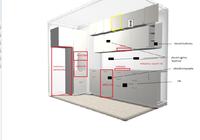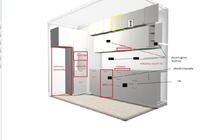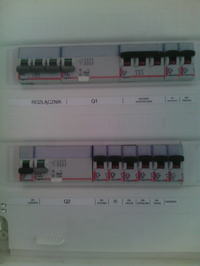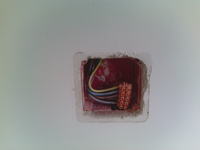Hello, we bought a new apartment and we are finally starting to do it, but there is a problem with the electrics for household appliances, namely the refrigerator, oven and microwave ... The problem is because the places where these appliances will be changed compared to what the developer came up with . The carpenter wanted to connect it all to the cables from an ordinary light switch, even when I was unfamiliar with electricity, I came to the conclusion that this was something wrong ...
In the kitchen I have "strength" and it will go under induction, I also have fuses and thus separate sockets for a dishwasher and refrigerator (and there is also a separate fuse called "kitchen", I think this one is for such junk as cooker hood, kettle, etc. ), so I hope that there are 2.5 mm2 cables and 16A fuses ... At the beginning I had the idea to put a 2.5 mm2 cable behind the furniture from the socket originally intended for the refrigerator, but whether the refrigerator, oven and microwave will not be too much?
Maybe the cable from the dishwasher's socket should be pulled under the microwave / refrigerator?
I'd rather not move my strength ...
ps. I don't know much about electricity so sorry if I write anything stupid.
ps.2 Forging walls is no longer an option, so I have to figure it out somehow ... the induction hob has "strength" and we leave it, but it also made a problem, because from what I read people connect 2 phases for induction, and 1 for the oven ... and because the oven goes to a different place, I have to connect the oven, fridge, microwave and dishwasher to two circuits, so from what I can see you will have to "pair" it somehow.
I think, shouldn't I configure it so that the oven with the fridge and the microwave with the dishwasher? I use the logic of counting the watts ... oven 2000-3000, fridge 600-800, microwave and dishwasher is max 3000 for both ...
Maybe in diffrent way? Oven with a microwave and not to use both?
In the kitchen I have "strength" and it will go under induction, I also have fuses and thus separate sockets for a dishwasher and refrigerator (and there is also a separate fuse called "kitchen", I think this one is for such junk as cooker hood, kettle, etc. ), so I hope that there are 2.5 mm2 cables and 16A fuses ... At the beginning I had the idea to put a 2.5 mm2 cable behind the furniture from the socket originally intended for the refrigerator, but whether the refrigerator, oven and microwave will not be too much?
Maybe the cable from the dishwasher's socket should be pulled under the microwave / refrigerator?
I'd rather not move my strength ...
ps. I don't know much about electricity so sorry if I write anything stupid.
ps.2 Forging walls is no longer an option, so I have to figure it out somehow ... the induction hob has "strength" and we leave it, but it also made a problem, because from what I read people connect 2 phases for induction, and 1 for the oven ... and because the oven goes to a different place, I have to connect the oven, fridge, microwave and dishwasher to two circuits, so from what I can see you will have to "pair" it somehow.
I think, shouldn't I configure it so that the oven with the fridge and the microwave with the dishwasher? I use the logic of counting the watts ... oven 2000-3000, fridge 600-800, microwave and dishwasher is max 3000 for both ...
Maybe in diffrent way? Oven with a microwave and not to use both?






